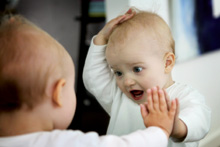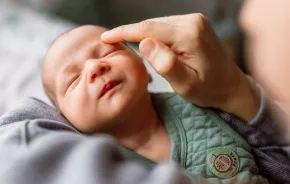 Her chubby little hands hold the towel slightly above her head while I pretend I can’t find her. With a giggle, she pulls the towel down, showing me her grin. She’s so excited she can’t stop bouncing her butt up and down, and I can’t stop smiling. Sixty seconds later, we do it all over again.
Her chubby little hands hold the towel slightly above her head while I pretend I can’t find her. With a giggle, she pulls the towel down, showing me her grin. She’s so excited she can’t stop bouncing her butt up and down, and I can’t stop smiling. Sixty seconds later, we do it all over again.
Peekaboo — or something similar — is a staple of most baby-rearing routines. But why are such games so fun and satisfying, both for our babies and for us? Is it just the game, or is there something deeper going on?
Reinforcing skills
Most experts agree that for babies, almost everything you do with them — including playing games — can help them learn and reinforce new skills. Playing “swat the dangling toy” with a 3-month-old, for example, helps hand-eye coordination, fine motor skills and visual development. Chasing a 6-month-old in a game of “I’m gonna get you!” helps with social development, balance and gross motor skills.
But Patricia Nan Anderson, an expert in child development and author of Parenting: A Field Guide, says baby games mean even more. Games are particularly satisfying for parents and children, Anderson believes, because they have a predictable “script,” in which parent and child each have a clear role. Even more, Anderson says, games help your baby communicate, even if she doesn’t yet know how to talk. “It’s like a conversation,” Anderson says, “done with the skills the child has and allowing them to be a full participant in the exchange.” This is in contrast to the rest of a baby’s life, in which the parent is usually in control. Your baby feels both a sense of unusual equality with you and a sense of accomplishment when the “script” is successful, because he did his part. And both parent and child feel the added connection.
Skill building aside, baby games are serious fun!
4 popular baby games, with variations and ideas for ages:
Peekaboo. Your baby won’t start learning the concept of “object permanence” (the idea that something does not stop existing just because she can’t see it) until about 6 to 9 months, but you can still have fun playing peekaboo before that age. Try drawing a face on a piece of paper and hiding behind it. For an older child, try hiding behind a cushion and letting your child pull the cushion away. Crawlers will have fun if you play peekaboo with a toy, hiding it behind you or under a nearby blanket. For toddlers, hide-and-seek with a toy is a variation that allows you to head out on a mission together — one in which you can pretend to be (and are) adventurers!
 Mirror play. Most babies don’t recognize themselves in a mirror until they are about 15 months old, but even babies as young as a few months can enjoy the experience of seeing a human face. Experts say mirror play helps in emotional, social and visual development. Try saying, “Who is that?” and pointing at the baby and her image.
Mirror play. Most babies don’t recognize themselves in a mirror until they are about 15 months old, but even babies as young as a few months can enjoy the experience of seeing a human face. Experts say mirror play helps in emotional, social and visual development. Try saying, “Who is that?” and pointing at the baby and her image.
When your baby is 3 to 6 months old, get a child-safe mirror or a “tummy time” mat with a reflective surface and you’ll also increase motor development. Older children love looking at themselves in the mirror, especially if you point at and touch parts of them, saying something like “Whose nose is that? It’s baby’s nose!” For toddlers, have them practice their mad, sad, scary, happy and other faces in front of a mirror, letting them see themselves in different ways.
Textures. Babies are incredibly interested in touch, even at birth. Touching is not just soothing — it helps with body awareness, emotional and social development, and tactile stimulation. When your baby is a newborn, try stroking his tummy with things with different textures, such as a piece of flannel, a warm, damp towel, a feather or a soft sweater. When he gets older, try sewing some of those textures onto a glove, securely, and letting him explore them on your hand, then show him your other, ungloved hand. Babies 9 to 12 months old will enjoy pulling pieces with different textures, shapes and weights out of an old shoebox — just make sure to stay with them if any of the pieces are fabric or something similar, because everything will (of course) end up in their mouths.
With older children, try using a blindfold and asking them to identify the items by touch alone. And toddlers will enjoy gluing different textures to a big piece of paper or stiff board in the shape of a spaceship, person or other interesting figures.
Bang the gong. Sound and rhythm can play roles, not just in listening, but also in tracking visually (i.e., following the item making the sound), learning cause-and-effect, increasing hand-eye coordination and even developing social skills. For a newborn, try stringing together some lightweight rattles, jar lids or similar items on a ribbon — securely — and dangle it over your baby.
When your baby is 3–6 months, let him sit in your lap and swat at the string, making the sound himself. At 6–9 months, get out the wooden spoons and pots — and a set of earplugs for yourself. Older kids will love to put on a concert for you with a homemade drum or other instrument; you can often find a used xylophone for a buck or two at a thrift store. And of course, from birth until your child is old enough to say, “You’re embarrassing me, Mom,” you should sing any silly song you like, anytime you like, whether you make up the words and tune or just go with an old standby like “Old MacDonald.”
Kathryn Russell Selk lives, works, writes and embarrasses her 6-year-old, Kiernan, and her husband, Christian, by making up really goofy songs and games for her 10-month-old, Kallison, in Seattle.
5 great books on skill-building games for babies
There are lots of good books with games for babies. Most of them are organized by age range (i.e. 0-3 months, 3-6 months) and include some information about the developmental milestones or skills the game reinforces.
Baby Minds: Brain-Building Games Your Baby Will Love, by Linda Acredolo and Susan Goodwyn; covers birth to age 3.
Baby Play, edited by Dr. Wendy S. Masi and Dr. Roni Cohen Leiderman – from the folks at Gymboree; covers up to 12 months.
Baby Smarts: Games for Playing and Learning, and Games to Play With Babies, both by Jackie Silberg; covers up to 12 months.
Playskool Guide to Baby Play, by Robin McClure; up to 12 months, this book has a neat “year of firsts” section describing interesting ways to celebrate events and holidays in your baby's first year.











